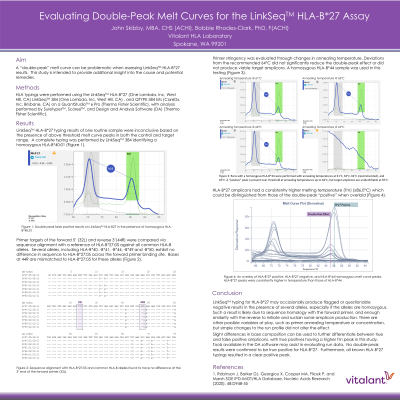Back

Evaluating Double-Peak Melt Curves for the LinkSeqTM HLA-B*27 Assay
(P712) Evaluating double-peak melt curves for the LinkSeqTM HLA-B*27 assay
Location: Platinum Ballroom

Poster Presenter(s)
Aim: A “double-peak” melt curve can be problematic when assessing LinkSeqTM HLA-B*27 results. This study is intended to provide additional insight into the cause and potential remedies.
Method: HLA typings were performed using the LinkSeqTM HLA-B*27, LinkSeqTM 384, and QTYPE 384 kits on a QuantStudioTM 6 Pro, with analysis performed by SuretyperTM, Score6TM, and Design and Analysis Software (DA).
Results: LinkSeqTM HLA-B*27 typing results of one sample were inconclusive based on the presence of above threshold melt curve peaks in both the control and target range. A complete typing was performed by LinkSeqTM 384 identifying a homozygous HLA-B*40:01 (Figure 1). Primer targets of the forward 5’ (32L) and reverse 3’(44R) were compared via sequence alignment with a reference of HLA-B*27:05 against all common HLA-B alleles.
Several alleles, including HLA-B*40, -B*41, -B*44, -B*49 and -B*50, exhibit no difference in sequence to HLA-B*27:05 across the forward primer binding site. Bases at 44R are mismatched to HLA-B*27:05 for these alleles (Figure 2).
Primer stringency was evaluated through changes in annealing temperature. Deviations from the recommended 64°C either did not significantly reduce the double-peak effect or did not produce viable target amplicons. A homozygous HLA-B*44 sample was used in this testing (Figure 3).
HLA-B*27 amplicons had a consistently higher melting temperature (Tm) (≥86.0°C) which could be distinguished from those of the double-peak “positive” when overlaid (Figure 4).
Conclusion: LinkSeqTM typing for HLA-B*27 may occasionally produce flagged or questionable negative results in the presence of several alleles, especially if the alleles are homozygous. Such a result is likely due to sequence homology with the forward primer, and enough similarity with the reverse to initiate and sustain some amplicon production. There are other possible variables at play, such as primer annealing temperature or concentration, but simple changes to the run profile did not alter the effect.
Slight differences in base composition can be used to further differentiate between true and false positive amplicons, with true positives having a higher Tm peak in this study. Tools available in the DA software may assist in evaluating run data. No double-peak results were confirmed to be true positive for HLA-B*27. Furthermore, all known HLA-B*27 typings resulted in a clear positive peak.
Method: HLA typings were performed using the LinkSeqTM HLA-B*27, LinkSeqTM 384, and QTYPE 384 kits on a QuantStudioTM 6 Pro, with analysis performed by SuretyperTM, Score6TM, and Design and Analysis Software (DA).
Results: LinkSeqTM HLA-B*27 typing results of one sample were inconclusive based on the presence of above threshold melt curve peaks in both the control and target range. A complete typing was performed by LinkSeqTM 384 identifying a homozygous HLA-B*40:01 (Figure 1). Primer targets of the forward 5’ (32L) and reverse 3’(44R) were compared via sequence alignment with a reference of HLA-B*27:05 against all common HLA-B alleles.
Several alleles, including HLA-B*40, -B*41, -B*44, -B*49 and -B*50, exhibit no difference in sequence to HLA-B*27:05 across the forward primer binding site. Bases at 44R are mismatched to HLA-B*27:05 for these alleles (Figure 2).
Primer stringency was evaluated through changes in annealing temperature. Deviations from the recommended 64°C either did not significantly reduce the double-peak effect or did not produce viable target amplicons. A homozygous HLA-B*44 sample was used in this testing (Figure 3).
HLA-B*27 amplicons had a consistently higher melting temperature (Tm) (≥86.0°C) which could be distinguished from those of the double-peak “positive” when overlaid (Figure 4).
Conclusion: LinkSeqTM typing for HLA-B*27 may occasionally produce flagged or questionable negative results in the presence of several alleles, especially if the alleles are homozygous. Such a result is likely due to sequence homology with the forward primer, and enough similarity with the reverse to initiate and sustain some amplicon production. There are other possible variables at play, such as primer annealing temperature or concentration, but simple changes to the run profile did not alter the effect.
Slight differences in base composition can be used to further differentiate between true and false positive amplicons, with true positives having a higher Tm peak in this study. Tools available in the DA software may assist in evaluating run data. No double-peak results were confirmed to be true positive for HLA-B*27. Furthermore, all known HLA-B*27 typings resulted in a clear positive peak.

